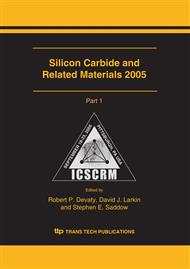p.1453
p.1457
p.1461
p.1465
p.1469
p.1473
p.1477
p.1483
p.1489
Minimum Ionizing Particle Detector Based on p+n Junction SiC Diode
Abstract:
In this work ion-implanted p+/n diodes have been used as minimum ionizing particle (MIP) detectors. The diode structure is based on a 0.45 $m deep, NA = 4×1019 cm-3 doped p+ anode, ion implanted in an n-type epilayer with thickness equal to 55 $m and nominal donor doping ND = 2×1014 cm-3. The diode breakdown voltages were above 1000V. At 1000V reverse bias the diode leakage current was of the order of 1 nA. The punch through depletion voltage was nearing the range 220-250 V. The charge collection efficiency to minimum ionizing particle was investigated by a 90Sr β source. The pulse height spectrum was measured as a function of the reverse voltage in the range 0-605 V. At each bias point the signal was stable and reproducible, showing the absence of polarization effects. At 220 V the collected charge was 2970 e- and saturated at 3150 e- near 350 V. At the moment, this is the highest collected charge for SiC detectors. At bias voltages over 100V the spectrum was found to consist of two peaks clearly separated. Around 250 V the signal saturates, in agreement with CV results.
Info:
Periodical:
Pages:
1469-1472
Citation:
Online since:
October 2006
Keywords:
Price:
Сopyright:
© 2006 Trans Tech Publications Ltd. All Rights Reserved
Share:
Citation:


